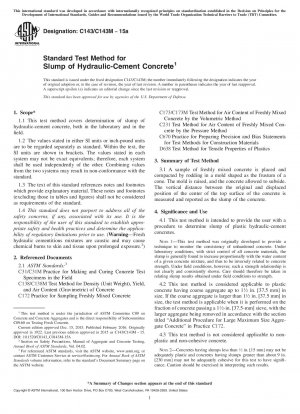ASTM C143/C143M-15a
Standard Test Method for Slump of Hydraulic-Cement Concrete
- Standard No.
- ASTM C143/C143M-15a
- Release Date
- 2015
- Published By
- American Society for Testing and Materials (ASTM)
- Status
- Replace By
- ASTM C143/C143M-20
- Latest
- ASTM C143/C143M-20
- Scope
4.1 This test method is intended to provide the user with a procedure to determine slump of plastic hydraulic-cement concretes.
Note 1: This test method was originally developed to provide a technique to monitor the consistency of unhardened concrete. Under laboratory conditions, with strict control of all concrete materials, the slump is generally found to increase proportionally with the water content of a given concrete mixture, and thus to be inversely related to concrete strength. Under field conditions, however, such a strength relationship is not clearly and consistently shown. Care should therefore be taken in relating slump results obtained under field conditions to strength.
4.2 This test method is considered applicable to plastic concrete having coarse aggregate up to 11/2 in. [37.5 mm] in size. If the coarse aggregate is larger than 11/2 in. [37.5 mm] in size, the test method is applicable when it is performed on the fraction of concrete passing a 11/2-in. [37.5-mm] sieve, with the larger aggregate being removed in accordance with the section titled “Additional Procedure for Large Maximum Size Aggregate Concrete” in Practice C172.
4.3 This test method is not considered applicable to non-plastic and non-cohesive concrete.
Note 2: Concretes having slumps less than 1/2 in. [15 mm] may not be adequately plastic and concretes having slumps greater than about 9 in. [230 mm] may not be adequately cohesive for this test to have significance. Caution should be exercised in interpreting such results.
1.1 This test method covers determination of slump of hydraulic-cement concrete, both in the laboratory and in the field.
1.2 The values stated in either SI units or inch-pound units are to be regarded separately as standard. Within the text, the SI units are shown in brackets. The values stated in each system may not be exact equivalents; therefore, each system shall be used independently of the other. Combining values from the two systems may result in non-conformance with the standard.
1.3 The text of this standard references notes and footnotes which provide explanatory material. These notes and footnotes (excluding those in tables and figures) shall not be considered as requirements of the standard.
1.4 This standard does not purport to address all of the safety concerns, if any, associated with its use. It is the responsibility of the user of this standard to establish appropriate safety and health practices and determine the applicability of regulatory limitations prior to use. (Warning—Fresh hydraulic cementitious mixtures are caustic and may cause chemical burns to skin and tissue upon prolonged expo......
ASTM C143/C143M-15a Referenced Document
- ASTM C138/C138M Standard Test Method for Density (Unit Weight), Yield, and Air Content (Gravimetric) of Concrete
- ASTM C172 Standard Practice for Sampling Freshly Mixed Concrete
- ASTM C173/C173M Standard Test Method for Air Content of Freshly Mixed Concrete by the Volumetric Method
- ASTM C231 Standard Test Method for Air Content of Freshly Mixed Concrete by the Pressure Method
- ASTM C31/C31M Standard Practice for Making and Curing Concrete Test Specimens in the Field
- ASTM C670 Standard Practice for Preparing Precision and Bias Statements for Test Methods for Construction Materials
- ASTM D638 Standard Test Method for Tensile Properties of Plastics
ASTM C143/C143M-15a history
- 2020 ASTM C143/C143M-20 Standard Test Method for Slump of Hydraulic-Cement Concrete
- 2015 ASTM C143/C143M-15a Standard Test Method for Slump of Hydraulic-Cement Concrete
- 2015 ASTM C143/C143M-15 Standard Test Method for Slump of Hydraulic-Cement Concrete
- 2012 ASTM C143/C143M-12 Standard Test Method for Slump of Hydraulic-Cement Concrete
- 2010 ASTM C143/C143M-10a Standard Test Method for Slump of Hydraulic-Cement Concrete
- 2010 ASTM C143/C143M-10 Standard Test Method for Slump of Hydraulic-Cement Concrete
- 2009 ASTM C143/C143M-09 Standard Test Method for Slump of Hydraulic-Cement Concrete
- 2008 ASTM C143/C143M-08 Standard Test Method for Slump of Hydraulic-Cement Concrete
- 2005 ASTM C143/C143M-05a Standard Test Method for Slump of Hydraulic-Cement Concrete
- 2005 ASTM C143/C143M-05 Standard Test Method for Slump of Hydraulic Cement Concrete
- 2003 ASTM C143/C143M-03 Standard Test Method for Slump of Hydraulic Cement Concrete
- 2000 ASTM C143/C143M-00 Standard Test Method for Slump of Hydraulic Cement Concrete
- 1978 ASTM C143-78 Standard Test Method for Slump Of Portland Cement Concrete

Copyright ©2024 All Rights Reserved